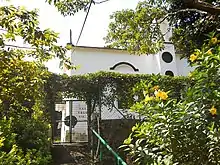Historic churches of Sai Kung Peninsula
The historic churches of Sai Kung form a group of 11 Roman Catholic churches and chapels established in the 19th and 20th centuries by missionaries in the Sai Kung Peninsula and surrounding islands, across modern day administrative areas: the Sai Kung District and Sai Kung North of Tai Po District.[1]

History
The churches were established by missionaries from the Seminary of Foreign Missions of Milan (now the Pontifical Institute for Foreign Missions).[2] The first missionary to take up residence in Sai Kung Peninsula, in 1865, was Fr. P. Gaetano Origo (1835-1868).[3] A first chapel was opened in the market town of Sai Kung in the late 1865.[4]:125
List of churches
Note: A territory-wide grade reassessment of historic buildings is ongoing. The churches with a "Not listed" status in the table below are not graded and do not appear in the list of historic buildings considered for grading.
| Location | Notes | Status | References | Photographs |
|---|---|---|---|---|
| Tai Long Tsuen (大浪村), Tai Long Wan 22.417524°N 114.371676°E |
Chapel of the Immaculate Conception (聖母無原罪小堂) Built in 1867. |
Grade III | _01.jpg.webp) | |
| Chek Keng 22.421198°N 114.349919°E |
Holy Family Chapel (聖家小堂). Built in 1874 to replace an earlier chapel that had been damaged by a storm in 1867. The whole village later converted to Catholicism. During the Japanese Occupation of Hong Kong, the chapel was a base of the Hong Kong-Kowloon Independent Battalion of the East River Guerrilla (東江縱隊港九獨立大隊). | Grade II |  | |
| Tan Ka Wan (蛋家灣) 22.451285°N 114.360923°E |
St. Peter's Chapel (聖伯多祿小堂) Built in 1873. It also housed the Sung Ming School (崇明學校). |
Pending | ||
| Sham Chung (深涌) 22.443210°N 114.286710°E |
Epiphany of Our Lord Chapel (三王來朝小堂) Established in 1879. Rebuilt in 1956. The Chapel housed a school called Kung Man School (公民學校), which had about 50 pupils and two teachers.[5] |
Pending | ||
| Pak Sha O (白沙澳) 22.44785°N 114.319266°E |
Immaculate Heart of Mary Chapel (聖母無玷之心小堂). A first chapel was built in Pak Sha O in 1880 on another site.[2] The conversion of Pak Sha O into a Catholic village partly resulted from the desire of the villagers to combat the harassment of the tax-lords of Sheung Shui. The current chapel was built between 1915 and 1923. The site is now used as a training campsite by the Catholic Scout Guild. | Grade III |  | |
| Yim Tin Tsai 22.377457°N 114.301681°E |
St. Joseph's Chapel (鹽田梓聖若瑟小堂) A first chapel was built in Yim Tin Tsai in 1866.[4] By 1875, the entire community of Yim Tin Tsai had embraced Catholicism.[2] Built in 1890, the current chapel received the Award of Merit by the UNESCO Asia Pacific Heritage Awards for Cultural Heritage Conservation in 2005. |
Grade II |  | |
| Pak Tam Chung (北潭涌) 22.391804°N 114.321110°E |
Our Lady of Sorrows Chapel aka. Our Lady of the Seven Sorrows Chapel (聖母七苦小堂) Built in 1900. |
Pending | _02.jpg.webp) | |
| Pak A (北丫), High Island 22.354425°N 114.349651°E |
Lung Shun Wan Mission Centre (龍船灣天主堂) Built in 1910. |
Not listed | ||
| Long Ke (浪茄) 22.376502°N 114.375000°E |
Nativity of Our Lady Chapel (聖母聖誕小堂) Built in 1918. |
Pending | ||
| Wong Mo Ying (黃毛應), Tai Mong Tsai 22.403394°N 114.295251°E |
Rosary Mission Centre (玫瑰小堂) Built in 1940. On 3 February 1942, the Hong Kong-Kowloon Independent Battalion under the People's Anti-Japanese Principal Guerrilla Force of Guangdong, or Dongjiang Guerrilla Force, was established in Wong Mo Ying Church.[6] |
Grade II |  | |
| Sai Wan, Tai Long Wan 22.395962°N 114.371073°E |
Star of the Sea Chapel aka. Star of the Sea Mass Centre (海星彌撒中心) Built in 1953. |
Pending |  | |
References
- "District Council Constitutency Boundaries - Tai Po District (Sheet 2)" (PDF). Electoral Affairs Commission. Retrieved 8 February 2021.
- Heaver, Stuart (27 February 2016). "The abandoned churches of Sai Kung: how Italian missionaries established Hakka congregations in Hong Kong". South China Morning Post.
- In Memoriam: Fr.P. Gaetano Origo
- Ticozzi, Sergio (2008). "The Catholic Church in Nineteenth Century Village Life in Hong Kong" (PDF). Journal of the Royal Asiatic Society Hong Kong Branch. 48: 111–149. ISSN 1991-7295. (A previous version of this paper was presented at a Seminar 'Hong Kong: its people, culture and traditions, the Centre of Asian Studies, University of Hong Kong. 15-16 April 1983)
- Antiquities Advisory Board. Historic Building Appraisal: Old House Ha Wai, Sham Chung Tsuen
- Chen Daming, Hong Kong's Anti-Japanese Guerrilla Force (香港抗日游擊隊) (Hong Kong: Universal Press, 2000), pp. 26-27; Choi Chung Man, "Sai Kung People's Support for the Hong Kong-Kowloon Independent Company" (西貢人民對港九大隊的支持), in Chui Yuet Ching, ed., Active in Hong Kong: A Record of Anti-Japanese Efforts of the Hong Kong-Kowloon Independent Battalion in Sai Kung (活躍在 香江:港九大隊西貢地區抗日實錄) (Hong Kong: Joint Publishing, 1993), pp. 168-172. (References cited in The Tai Po Book, p. 205).
Further reading
- Xia, Qilong (1998). The foundation of the Catholic mission in Hong Kong, 1841-1894 (Ph.D. Thesis). The University of Hong Kong.
- von Hübner, Joseph Alexander Graf (1874). A Ramble Round the World, 1871. Macmillan and Co, London; translated by Baroness Mary Elizabeth Herbert. pp. 373-378. (From 23 to 25 November 1871, Count Joseph Alexander Hübner, accompanied by Timoleon Raimondi, visited Christian settlements in the part of China's Xin'an County (Se-non, 新安) that would become the New Territories of Hong Kong in 1898.)
- Constable, Nicole (August 1994). Christian Souls and Chinese Spirits: A Hakka Community in Hong Kong. University of California Press. ISBN 9780520083844. (about a Chistian Hakka community in Shung Him Tong Tsuen, Fanling)